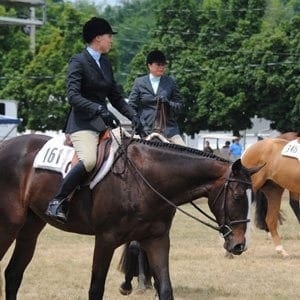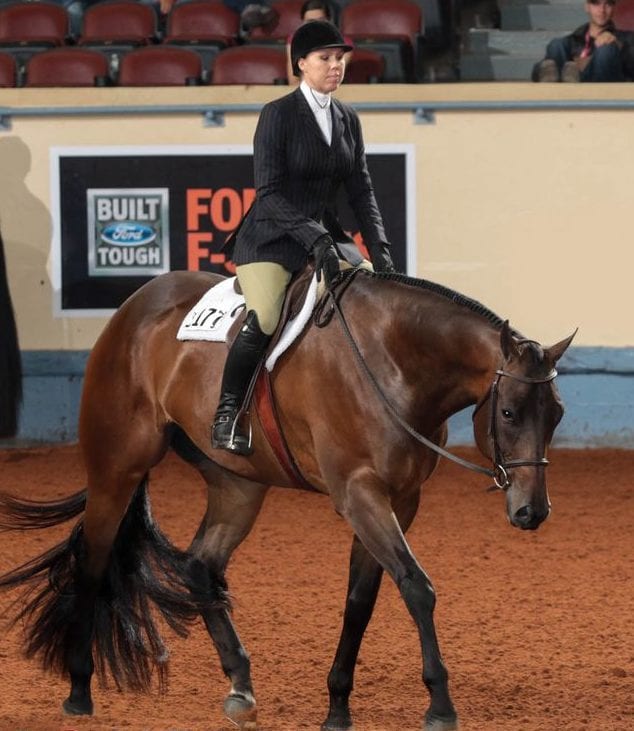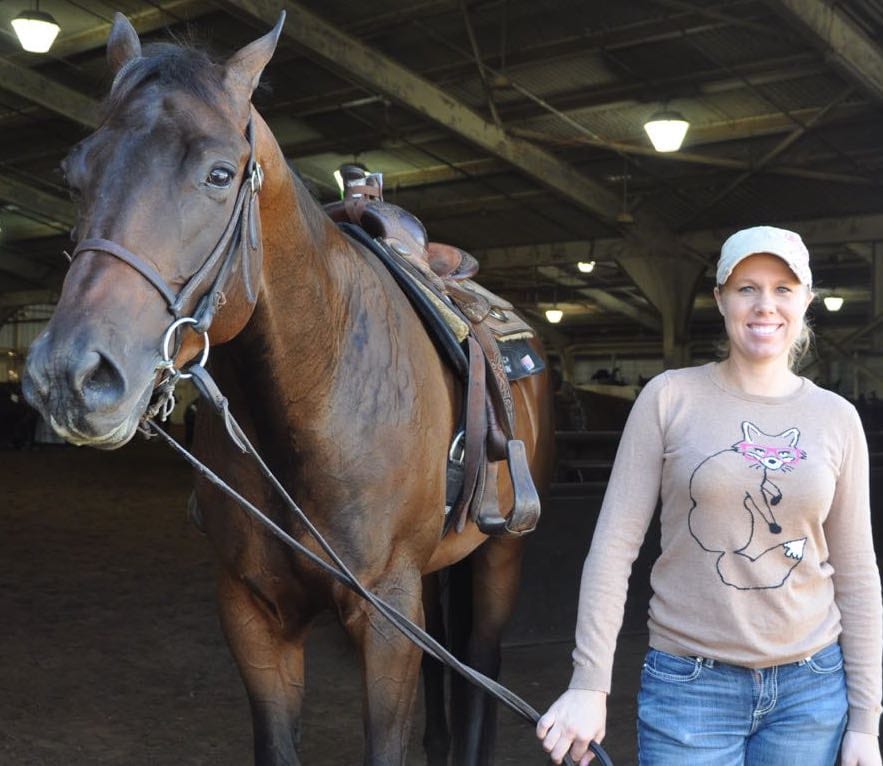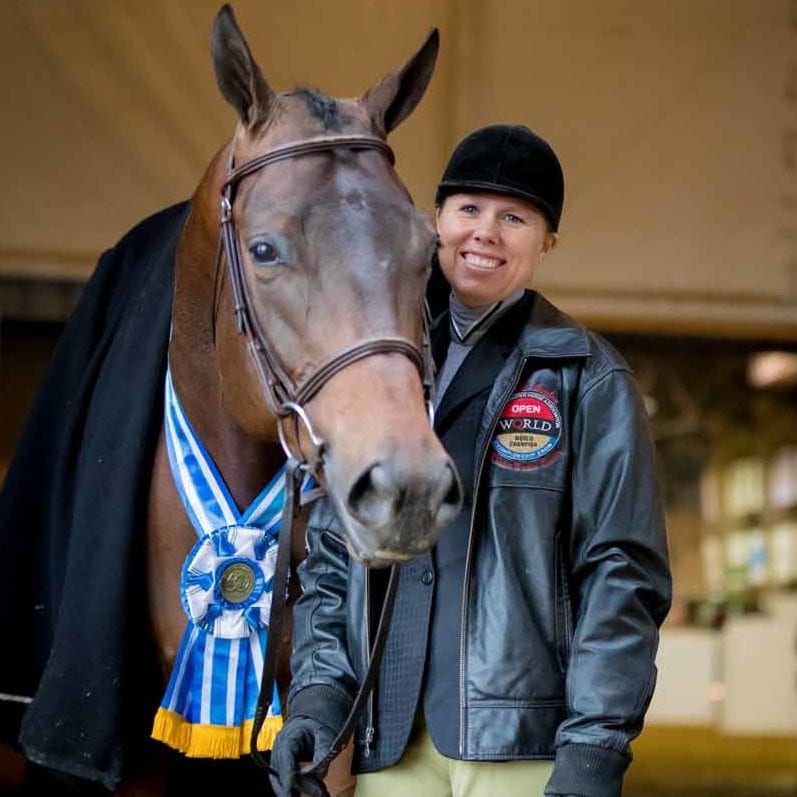GoHorseShow, in partnership with SmartPak, is pleased to continue our highly popular GoSmart column featuring in this installment, Charlie Cole and Beth Case of Highpoint Performance Horses. Team SmartPak riders, Charlie Cole and Beth Case have achieved success beyond compare. Highpoint Performance Horses has trained over 100 World Champions and 200 All-American Quarter Horse Congress Champions. These days, Case is in charge of the hunter under saddle horses where she has won every major hunter under the saddle title in the industry multiple times.
The Highpoint team recently had a phenomenal NSBA World Show and Select World Show in the hunter pen, with world titles left and right. We sat down with Charlie and Beth to talk about five particular bad habits in hunter under saddle horses, and how to correct those problems effectively.
1. The Anticipator
Horses are incredibly smart animals. This can be a good or bad attribute in the show pen. A common problem with hunter under saddle horses is learning to listen to the announcer for transitions instead of to their rider’s cues. Horses can become anxious and quicken their pace. One of the simplest ways to help this is to make your horse wait for your cue.
 “To maintain them, you never want to do anything right when the announcer says it,” Case said. “You want to wait a few seconds or a few strides and then do it. If you always do it the second the announcer clicks on or the first time they talk, your horse learns that. They learn that for upward transitions and downward transitions. You have to make sure you’re the one in charge, not the announcer.”
“To maintain them, you never want to do anything right when the announcer says it,” Case said. “You want to wait a few seconds or a few strides and then do it. If you always do it the second the announcer clicks on or the first time they talk, your horse learns that. They learn that for upward transitions and downward transitions. You have to make sure you’re the one in charge, not the announcer.”
Riders can induce this behavior in their horses too. Exhibitors tend to be more stressed in the show pen and tighten every part of their body.
“With one like that, a lot of it is rider induced from riders having anxiety and them getting anxious, tightening up, and anticipating transitions,” Cole said. “Part of it is the rider needing to stay relaxed and not tighten up and not shorten the stride up, say at the walk or something.”
It may sound obvious, but Cole highly recommends working on the walk. The walk is pivotal in having a calm and relaxed horse throughout the class.
“I would say practice the walk and practice lengthening the walk for a more forward and longer strided walk,” Cole said. “You see a lot of riders when they are anticipating, they crank up on their horse and almost take the walk to where it’s nothing, which gives the horse more anxiety. A nice long walk will help that a lot.”
2. The Low Rider
 There have always been debates about where a horse should carry their head in the hunter under saddle pen. We can all agree, there is a point where the head is too low. Sometimes you can’t help it as much because of how the horse is built. If it runs downhill, you are already at a disadvantage and have to ride through it.
There have always been debates about where a horse should carry their head in the hunter under saddle pen. We can all agree, there is a point where the head is too low. Sometimes you can’t help it as much because of how the horse is built. If it runs downhill, you are already at a disadvantage and have to ride through it.
“To fix this, shorten your reins and hold their head where it needs to be,” Case said. “You should have the contact anyway. That’s a simple fix.”
“When you go into the arena you have to let them come up to a level that is acceptable and fits their body type also,” Cole said. “Each horse is different. Some horses look a little better lower and some look better higher. I think you have to look at each horse as an individual and where they look the best. If one is too low, Beth is excellent about bringing a horse’s front end up. She will continually lift them up and find a happy spot there.”
3. The Wiggle Worm
 An important part of the hunter under saddle class is the entrance. The straight line down the middle and on the rail can be a struggle for all ages of horses. We call these the wiggle worms. Case and Cole shared some easy tactics for riders to try to break this habit.
An important part of the hunter under saddle class is the entrance. The straight line down the middle and on the rail can be a struggle for all ages of horses. We call these the wiggle worms. Case and Cole shared some easy tactics for riders to try to break this habit.
“I have one that does this to its owner,” Case said. “He goes back and forth and back and forth. My rider kept telling me he won’t go straight, he just keeps going left and right. I showed him, and he tried to do that, so I told her all you have to do is widen your hands and kick him straight through. Kick him forward. She was struggling, and when he went left, she pulled right and vice versa. She was pulling him back and forth. Kick your horse straight forward through the middle of the reins. Kick them straight. Widen your hands evenly, so you’re not pulling them back and forth and push them into the bridle. Don’t try to overcorrect it. That will make them go back and forth instead of straight.”
“A horse like that you’ve got to keep between your legs,” Cole said. “Everyone wants to go to their mouths to get control, but more power comes from keeping the horse between your legs and right below you in your seat. I would say you have to use your hand and leg together to keep a horse like that straight and moving forward. A lot more leg and leg contact with your horse will help.”
4. The Seasoned Veteran
 Highpoint has created many champions in the show pen that win for continuous years. They are sure to school their horses in other disciplines and not work them into the ground. Horses can become naughty if they are drilled to do the same thing over and over again, every day.
Highpoint has created many champions in the show pen that win for continuous years. They are sure to school their horses in other disciplines and not work them into the ground. Horses can become naughty if they are drilled to do the same thing over and over again, every day.
“We’ve been good at that and able to keep those horses going for a long time,” Cole said. “I think at home, we like to do different things with them. Anytime you do the same thing over and over again with a horse, they tend to get bored. You’ll see Beth work a lot of western riding with her hunt seat horses. We used to jump a ton of them. I think jumping can be the best thing for a hunt seat horse. It gets them round and using their back. When they’re broke, you are better off practicing other things and then working on your hunt seat at the show or a little before. We try not to drill them into the ground to where they hate their job.”
Case agreed, turn out time was beneficial along with not practicing with them over and over again at the show or at home.
“At home, mine get turned out every single day that it’s not raining,” Case said. “That keeps them happy. When I’m at horse shows, I don’t ride, ride, and ride them. I ride them and if they are good, they get put up. If they need to be more tired, they get longed for a while longer. They know their job. You don’t need to keep schooling them. If they are good, put them up and let them know they are good. Don’t try to train something that’s already trained.”
5. The Scaredy-Cat
 Some horses seem to be claustrophobic and panic whenever they get in heavy traffic in the show pen. It can happen to both the young and experienced ones. Case and Cole shared tips anyone can use to help with this problem.
Some horses seem to be claustrophobic and panic whenever they get in heavy traffic in the show pen. It can happen to both the young and experienced ones. Case and Cole shared tips anyone can use to help with this problem.
“My two-year-old this year is great-legged and I love her, but when I ride her, she’s not very broke,” Case said. “She is terrified of traffic and I have been trying the last six months to get her over that. It’s the hardest thing in the world. I pony those horses a lot. I’ll tie them up in the middle of the arena and just ride around them. You can’t ride right at them, it freaks them out. I try to ride around them and stop to pet them and tell them they’re good. You want to get angry with them, but you can’t because it will just make it worse. You have to let them know it’s okay. You have to ignore it and sit there to let them calm down.”
 “We do a lot of ponying on those kinds of horses. I think it can help a lot,” says Cole, who echoes Case with regards to helping scared horses. “That would be the number one thing I would recommend with a horse like that. I don’t think you can punish one for being scared because they get more scared being worried about getting punished. You have to take your time and work through it. Go somewhere you can ride with traffic that’s all going the same way as you, so you can practice walking, trotting, and cantering next to a horse. Just slowly work over it. Typically horses that are afraid have just lost their confidence. Many times riders will correct them and take away more confidence. You have to learn to ride forward through it and almost ignore it. They will start ignoring it also. If you make a big deal about it, they usually get worse.”
“We do a lot of ponying on those kinds of horses. I think it can help a lot,” says Cole, who echoes Case with regards to helping scared horses. “That would be the number one thing I would recommend with a horse like that. I don’t think you can punish one for being scared because they get more scared being worried about getting punished. You have to take your time and work through it. Go somewhere you can ride with traffic that’s all going the same way as you, so you can practice walking, trotting, and cantering next to a horse. Just slowly work over it. Typically horses that are afraid have just lost their confidence. Many times riders will correct them and take away more confidence. You have to learn to ride forward through it and almost ignore it. They will start ignoring it also. If you make a big deal about it, they usually get worse.”
These two share many of the same training techniques and approaches to the hunter under saddle horses. They have great tips and tricks to correct the annoying problems we experience in the show pen. The majority of our problems are brought on by us. Case gave one last piece of advice to wrap up this session.
“Don’t think so much about it,” Case said. “Just ride your horse and have fun. People make it a lot harder than it is.”
Photos © AQHA, NSBA, Impulse Photography
About the Author: GoHorseShow writer, Courtney Hall is a graduate student at Missouri State University. She is obtaining a Master’s Degree in Agriculture with research in Agricultural Communications. She started showing the APHA & AQHA all around circuit as a youth and continues today as an amateur.








